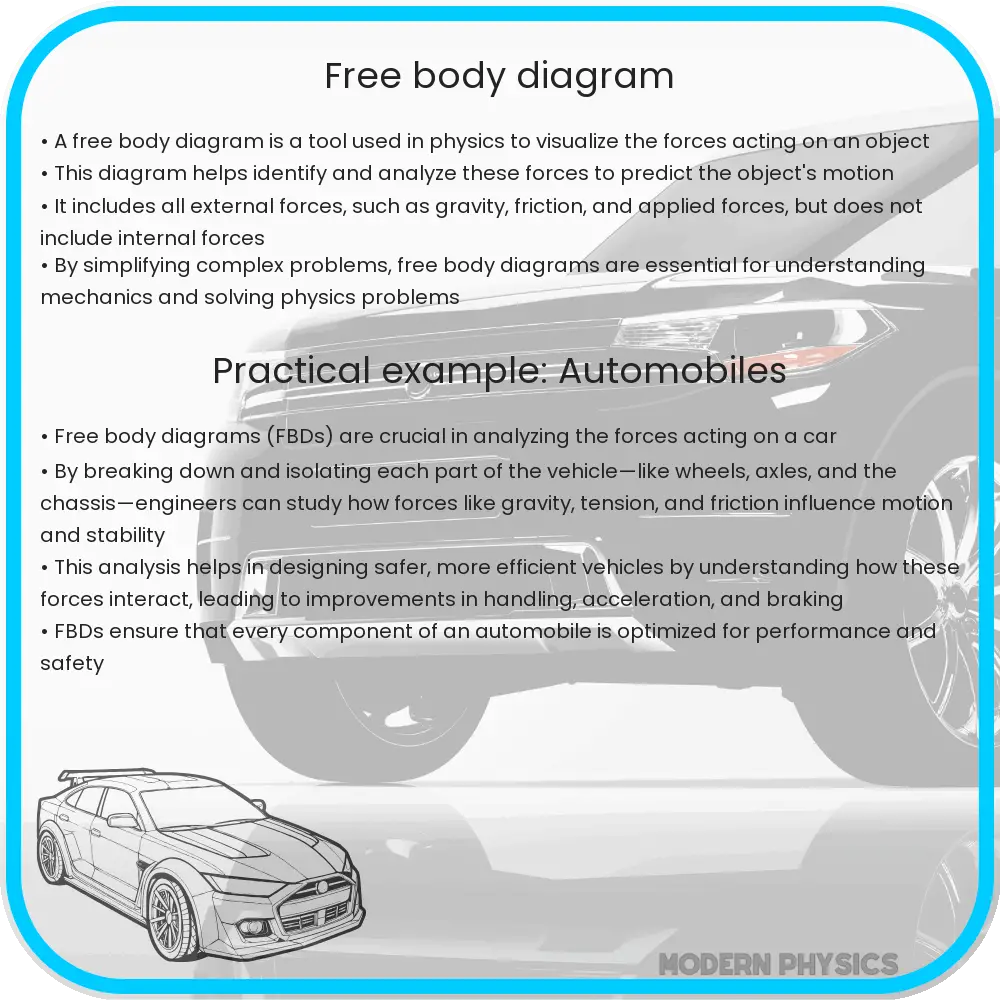Explore the essentials of Free Body Diagrams, their role in physics and engineering, and advanced applications in mechanical and structural analysis.

Understanding Free Body Diagrams: Basics and Applications
Free Body Diagrams (FBDs) are a fundamental tool in the fields of physics and engineering, providing a simplified representation of forces acting on an object. These diagrams are crucial for analyzing the mechanical stability and dynamics of a system. By isolating an object and illustrating all external forces, moments, and reactions, FBDs enable a clearer understanding of the mechanics involved.
Components of a Free Body Diagram
A typical Free Body Diagram includes the following elements:
- Reference Object: The diagram focuses on a single object, often represented as a dot or a simple shape.
- Force Arrows: Forces acting on the object are depicted as arrows pointing in the direction of the applied force. The length of the arrow often indicates the magnitude of the force.
- Force Labels: Each arrow is labeled with the type of force it represents, such as gravitational force (Fg), normal force (N), tension (T), and friction (f).
- Point of Application: The point where the force is applied on the object is also indicated.
Principles of Equilibrium in Free Body Diagrams
In physics, equilibrium refers to the state where the sum of forces and moments on an object is zero, resulting in the object being at rest or moving with constant velocity. To analyze this condition using a Free Body Diagram, the following principles are applied:
- Newton’s First Law of Motion: An object remains at rest or in uniform motion in a straight line unless acted upon by a force.
- Summation of Forces: The vector sum of all forces acting on the object must equal zero for translational equilibrium.
- Summation of Moments: Similarly, the sum of all moments about any axis must also be zero for rotational equilibrium.
This basic analysis can be expanded to more complex scenarios involving multiple forces and constraints. The next section will delve deeper into practical applications and more advanced concepts of Free Body Diagrams.
Advanced Applications of Free Body Diagrams
Free Body Diagrams are not limited to simple scenarios. They are equally essential in analyzing complex systems, such as in mechanical engineering, structural analysis, and biomechanics. Advanced applications often involve:
- Multiple Forces: Complex systems may have numerous forces acting in different directions, including applied forces, frictional forces, air resistance, and more.
- Dynamic Conditions: In dynamic scenarios, where acceleration is involved, Newton’s Second Law (\( F = ma \)) becomes crucial in calculating the resultant force.
- Non-Coplanar Forces: In three-dimensional problems, forces may not act in the same plane, necessitating a more intricate analysis of the vectors.
Challenges in Constructing Free Body Diagrams
While FBDs are powerful tools, they also present certain challenges:
- Identifying Relevant Forces: It can be challenging to discern which forces are relevant to the problem at hand and should be included in the diagram.
- Assumptions and Simplifications: Sometimes, assumptions must be made to simplify the problem, such as neglecting air resistance or considering surfaces as frictionless.
- Accurate Representation: The accuracy of a Free Body Diagram is crucial; misrepresentation of force direction or magnitude can lead to incorrect conclusions.
Conclusion
Free Body Diagrams are an indispensable tool in understanding and solving problems in physics and engineering. They provide a clear and simplified representation of all forces acting on an object, making it easier to analyze the conditions of equilibrium and motion. Whether in educational settings or in practical engineering applications, mastering the art of drawing and interpreting Free Body Diagrams is crucial for anyone dealing with the principles of mechanics.
While challenges exist in their construction, the ability to accurately depict and analyze forces through Free Body Diagrams is a skill that yields profound insights into the behavior of physical systems. As such, they remain a fundamental aspect of scientific and engineering education, equipping students and professionals with the knowledge to tackle complex mechanical problems.
